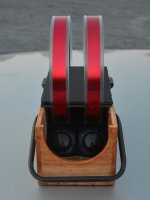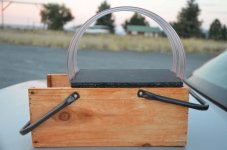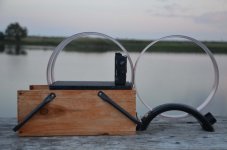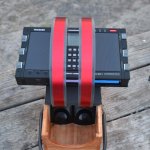After more than ten years, I broke my C Crane Radio EP. It is a portable. So, I bought the EP PRO. I was not impressed.
So, I open both. Overall design and layout has not changed. However, the analog Sanyo LA 1260 AM/FM/MPX was not upgraded using the newer Sanyo LA 1823/4 but with the Silicon Labs / Skyworks Si 4730. This is a Digital RX DSP receiver with no inductors or potentiometers to adjust. Only a single mini VCO variable cap to diddle. Only analog components on the receive side is a dial string on a pot.
The 200 mm by 10 mm ferrite loop antennas are near identical. So, I’m thinking a good radio is only as good as its antenna ... why not have two. There is room after cutting out the three antenna support stanchions. So, I cable tie the two loops together then wire them IN SERIES. Yes, this doubles the ohms. Voltage is the point. Close proximity quadruples the henries and broadens the lower and upper MW BCB. After removing near 80 mm of extraneous litz wire, the dual ferrite loop assembly is rubber cemented together, assembly is soldered to the main PCB which is re-installed then the assembly is rubber cemented to the back chassis. Takes five hours. Four hours for the glue to dry.
Immediate results are impressive. There are no analog test points to measure. But, the red signal strength LED seems to light with more distant stations twice as much. So, I did some field testing in urban EMI environments and at a remote pond swamp. Wide / Narrow filter remains very good but Fine Tuning is not as effective. I’m thinking it’s the digital electronics and not the antennae. C Crane does not offer service manuals for either radio. Buy a new one. It’s a Sangean.
Rhombics and loops are most effective for AM DX. However, size and weight are issues. With this dual antenna, side lobes seem to be more suppressed but this may be due to on lobes being more sensitive. On night two, I brought out the Tecsun H-501X for side by side comps. EP PRO has more directional side lobe nulling and at higher frequencies. EP PRO has less fade and with different phases perhaps due to it being more sensitive to M than E waves than the Tecsun single ferrite loop. Proven at the pond when the EP PRO is oriented vertical and performs much like the original C Crane Twin Coil which it is not. That twin coil is a reverse phase design requiring a transformer and pre-amplification. It was quieter to EMI and CMR but fails in the market due to inductive coupling difficulties and the direct coupling impedance matches C Crane radios but not many others (5:1 balbal).
H-501X is more selective. There is no adjacent channel interference. None. AGC is very good. EP PRO is not. Its AGC will lock up and soft mute. H-501X four speaker audio has more fidelity and presence. EP PRO two speaker audio is more intelligible. This is important for crowded noisy AM reception.
On night three, I brought out both radios and a Tecsun AN-200 inductive loop antenna. Results are more impressive. With both radios inside the loop, modified EP PRO has more sensitivity, directivity and less fade than H-501X. Propagation delays have faster rise and fall times. Additional Q makes low band frequency channels more selective with AN-200 fine tuning. Side lobe nulls seem sharper. I listened to three stations in different directions on the same frequencies above 1300 kHz. Loop coupling is more effective with internal dual antennas than the H-501X single antenna. It has broad fine tune peaks while EP PRO is more narrow (Q). I have not used the direct connect method using RF cables. Tecsun does not allow for external AM antennae. C Crane may have Z and CMR issues. Later maybe.
ON VHF BCB using whip antennas only, H-501X is more selective and has better stereo audio quality on headphones. However, EP PRO has better capture and locks MPX stereo pilot sooner with 80 mm less whip. I listened to an 18 kW ERP FM station 160 miles away with no LOS (mountains) at times in stereo. H-501X needs an external antenna to achieve similar or better performance. Basic conclusion is Tecsun has better sound, C Crane has more to listen to.
This EP PRO will replace the GE SR2 (finally). Four carbon or alkaline D cells give this monster gravitas.
Only one thing will make the EP PRO and AN-200 combo better. Two AN-200s side by side with radios inside both loops. Will 3-D print the frame as soon as the second arrives from China.
And then, there is the Qudosen SR-286 dual antenna project. First attempt using a Sony ferrite loop with different coil windings fails even though the math was good (parallel series). If you enjoy analog radio the way Providence intended, this SR-286 may be the light weight portable yer lookin’ fer.
Chico Baravelli
cbaravelli@mail.com






